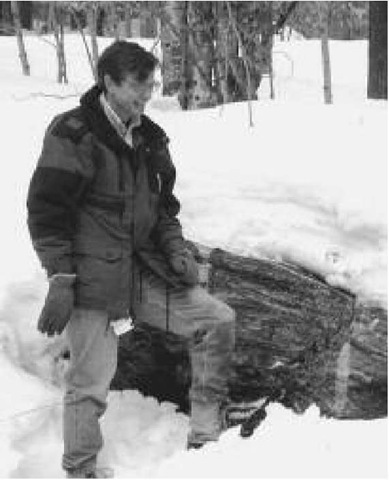(1949- ) American Metamorphic Petrologist
Frank Spear is one of the world’s premier meta-morphic petrologists/geochemists. He was one of the leaders in a revolution in metamorphic petrology that occurred in the late 1970s and early 1980s. His first paper was perhaps the most cited and important in metamorphic geochemistry. With John Ferry, he did an experimental calibration for the geothermometry of metamor-phic rocks containing coexisting garnet and bi-otite. The two minerals exchange Fe and Mg depending upon the temperature. As a result of this work, by analyzing the Fe and Mg contents of these common minerals in any rock, temperatures of formation can be accurately determined. Nearly everyone who was working in a metamor-phic terrane containing aluminous rocks almost immediately determined the geothermometry using these techniques. The impact on the field, which could now determine actual paleotempera-tures where previously they had just been estimated, was astounding. That paper heralded a whole series of experimentally and theoretically determined geothermometers and geobarometers based on assemblages of common metamorphic minerals.
Although Spear did some outstanding work on the occurrence and quantitative geochemistry of amphiboles and amphibole-bearing assemblages, his next study that made a big impact on the field was on methods to quantitatively analyze pressure-temperature paths from zoned minerals. The paper, “Quantitative Pressure-Temperature Paths from Zoned Minerals: Theory and Tectonic Applications,” was done with his graduate student jane selverstone. These analyses allowed researchers to calculate the P-T history of a rock rather than just its final conditions. Based on the shape and position of the calculated path on a graph of pressure versus temperature, regional tectonic models could be interpreted. Zoned minerals acted as recording tape for tectono-metamorphic histories. Characteristic P-T loops of early high pressure followed by high temperature and finally retrogression were found to be common. Spear and his coworkers examined rocks from several areas to perform these analyses, including the Tauern Window, eastern Alps, the Scandinavian Caledonides, and western New England. Spear developed computer programs to perform these complex but exciting analyses and took the unprecedented step of making them openly available to all geologists. Prior to this, quantitative meta-morphic geochemistry was somewhat akin to magic.
The next step in this progression was to add a timing component to the path. Frank Spear collaborated with t. mark harrison to analyze Ar/Ar in the metamorphic rocks that were analyzed for P-T paths. The result is an even more powerful Pressure-Temperature-time (P-T-t) path, which he described in his book, Metamor-phic Pressure-Temperature-Time Paths. Now, not only could geologists tell if the rocks being studied were loaded beneath a thrust nappe, they could tell how fast they were loaded and for how long. It was as if aluminous metamorphic rocks kept a journal of their history. This method was applied to rocks in western New England and the Cordillera of Tierra del Fuego, South America, but it required a lot of cooperation and even then many of the results were questioned and the method was not as vigorously pursued as previous ventures.
Neither rain nor snow stops Frank Spear from visiting rock exposures, as he does here in New Hampshire
Frank Spear then became interested in diffusion in minerals and especially garnet. With these open systems of exchanging elements, how much was really being recorded and under what conditions? He looked at trace element zoning in garnets and developed a new method for performing 3-D imaging of garnets for different elements in contrast to the standard 2-D analysis as described in the paper, “Three Dimensional Patterns of Garnet Nucleation and Growth.” The method involved performing a series of 2-D elemental scans at a series of parallel slices through the garnet and then computer stacking the results to form a 3-D image. Mineral zonation analysis was taken to a new level through this method.
Frank S. Spear was born in Connecticut on March 9, 1949. He earned a bachelor of arts degree from Amherst College, Massachusetts, in 1971 with a major in geology. He earned his doctorate from University of California at Los Angeles in 1976, also in geology. He was awarded a postdoctoral fellowship at the Geophysical Laboratory at the Carnegie Institute of Washington, D.C., from 1976 to 1978. In 1978, he joined the faculty at Massachusetts Institute of Technology, where he remained until 1985. He then moved to Rensselaer Polytechnic Institute, New York, where he became a full professor in 1988 and chair of the department in 1999. Frank Spear has two children.
Frank Spear is an author of 79 papers in international journals and professional volumes. He is also an author of two books. He was a Schlum-berger Professor at Massachusetts Institute of Technology and a Weeks Visiting Professor at University of Wisconsin at Madison. He was awarded the N.L. Bowen Award from American Geophysical Union. He served as editor for Geological Materials Research and associate editor for American Mineralogist and Journal of Metamorphic Petrology. He has served on countless committees for the American Geophysical Union, the Mineralogical Society of America, and the Geological Society of America. He also presented several short courses worldwide on his P-T-t techniques.

